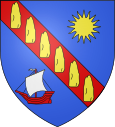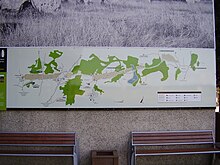Carnac
|
Carnac Karnag |
||
|---|---|---|

|
|
|
| region | Brittany | |
| Department | Morbihan | |
| Arrondissement | Lorient | |
| Canton | Quiberon | |
| Community association | Auray Quiberon Terre Atlantique | |
| Coordinates | 47 ° 35 ′ N , 3 ° 5 ′ W | |
| height | 0-45 m | |
| surface | 32.71 km 2 | |
| Residents | 4,251 (January 1, 2017) | |
| Population density | 130 inhabitants / km 2 | |
| Post Code | 56340 | |
| INSEE code | 56034 | |
| Website | https://www.carnac.fr/ | |
Carnac ( Breton Karnag ) is a commune on the Atlantic coast with 4,251 inhabitants (at January 1, 2017) in the Morbihan department in the region of Brittany . It is famous for its more than 3000 menhirs , which are grouped into rows of stones (French alignements ). The stone enclosures of Brittany and several large stone graves ( dolmens ) are also close to the place.
tourism
The climatically stable south coast of Brittany with its many bays and sandy beaches has been popular with the French since the 1920s. Since the 1960s, visitors from other European countries have also come to visit the many prehistoric sights in Carnac and its surroundings. The Plouharnel - Carnac station on the Auray – Quiberon railway line is served by excursion trains in summer. Until 1935 there was a tram that connected the station, town and beach with each other and with the neighboring towns of La Trinité-sur-Mer and Étel .
Monuments
The rows of stones, the single standing menhirs and the dolmens consist essentially of the granite rock of the coast exposed to the sea. Many surfaces are now partially weathered and covered with lichen. While the older stones in the rows of stones and the dolmens were usually carefully processed, there are hardly any traces of processing to be found in later stone setting.
Rows of stones

The rows of stones form the groups of Kerlescan , Le Menec and Kermario . The rows are over three kilometers long and originally contained over 3000 stones that are between 0.5 and 4.0 m high. The largest stones are always at the western end. The original extent was probably 8 km, and the complex also included the monuments of Le Petit Menec , St. Barbe and Kerzerho . The ranks thus extended from Crac'h Ria to Plouharnel .
- Menec has stone circles at both ends (90 and 110 m in diameter). The row of stones changes its orientation once, which some researchers see as an indication of a construction in two phases.
- At Kermario, the remains of the stone circle at the west end can still be seen in aerial photographs. The row of stones changes direction three times.
- Kerlescan has a stone circle on the west end, apparently not in the east. It consists of 13 parallel rows containing between seven and 41 stones. Part of the megaliths was already in the form of blocks, many of the smaller ones were broken out of the rock.
During the Second World War, National Socialist archaeologists from the Einsatzstab Reichsleiter Rosenberg were commissioned to measure the rows of stones and to carry out an excavation especially on the stone rows of Kerlescan. Most of the finds from the excavation are still in the Carnac Museum to this day. Serge Cassen sees the rows of stones as a line of defense against supernatural dangers emanating from the sea.
Tumulus St. Michel
The Tumulus St. Michel is the largest man-made mound of earth in France (length 125 m, width 60 m, height about 10 m). It contains a number of stone boxes and a dolmen that could be viewed through a tunnel. Since the excavation made the mound unstable, the tunnels are now closed to the public. At the top of the burial mound there is a chapel for the Archangel Michael and a stone cross. From here you have a good view of the Gulf of Morbihan . Comparable large tumuli in the area are the Le Petit Mont near Arzon and the facilities of Er Grah , Mané Lud , Tumulus du Moustoir and Mané-er-Hroëk near Locmariaquer .
Great stone graves
The Kerluir and Beaumer dolmens are on the outskirts . There is another dolmen in town, Belle-Vue on Rue de Courdiec. The Berlin Society for Anthropology, Ethnology and Prehistory presented a brief description of the current research on megalithic graves in the Carnac region. During the German occupation of Brittany (1940-1944), several large stone graves were damaged or destroyed by trenches and entrenchment work by the Todt Organization and the Wehrmacht.
Ancient settlement
The Camp du Lizo is a hillside settlement . It was built at the end of the Bronze Age and is the only one in the region to be explored. The camp, located on a plateau above the Crac'h River northeast of Carnac, was investigated between 1923 and 1926 by Zacharie Le Rouzic (1864–1939).
Dating
The megalithic complexes were built in the Neolithic Age (from approx. 4500 BC) and were used until the Bronze Age (approx. 2300 BC). The rows of stones are usually dated to the late Neolithic ; The bases for dating (skeletal remains or ceramic finds) are, however, sparse and could also come from later times. The rows of stones from Kermario run over the ancient neolithic long hill of Le Manio .
museum
In the building of a former seminary in the center of Carnac is the 'Musée de Prehistoire' with interesting exhibits and information on megalithic structures. Some showcases are dedicated to Roman times and the Middle Ages (see web link).
Personalities
- Paul Goffeny (1907–1945), highly decorated French naval pilot
- Delphine cousin Questel (* 1991), multiple windsurfing world champion
Town twinning
- Illertissen , Germany
- La Clusaz , Haute-Savoie department , France
literature
- Pierre-Roland Giot: Les Alignements de Carnac. = The alignments of Carnac. Éditions Ouest-France, Rennes 1992, ISBN 2-7373-1021-0 .
- Mark Patton: Statements in stone. Monuments and society in Neolithic Brittany. Routledge, London et al. 1993, ISBN 0-415-06729-4 .
- D. Sellier: Éléments de reconstruction du paysage prémégalithique sur le site des alignements de Kerlescan (Carnac, Morbihan) à partir de critères géomorphologiques. In: Revue archéologique de l'Ouest. 12, 1995, ISSN 0767-709X .
- Jürgen E. Walkowitz: The megalithic syndrome. European cult sites of the Stone Age (= contributions to the prehistory and early history of Central Europe. Vol. 36). Beier & Beran, Langenweißbach 2003, ISBN 3-930036-70-3 .
Individual evidence
- ^ Reena Perschke: Les mégalithes du Morbihan littoral sous l'occupation allemande (1940–1944). In: Bulletin et Mémoires du Morbihan. Part CXXXIX, Société Polymathique du Morbihan, Vannes 2013, pp. 63-89.
- ^ Werner envelope: The stones of Carnac. JA Barth publishing house, Leipzig 1942.
- ↑ Serge Cassen: Exercice de stèle: une archéologie des pierres dressées, réflexion autour des menhirs de Carnac. Errance, Paris 2009, ISBN 978-2-87772-394-7 .
- ↑ Reena Perschke: Nothing but large stones? The megalithic tombs of Carnac, Quiberon and the Golfe du Morbihan. In: Communications from the Berlin Society for Anthropology, Ethnology and Prehistory. Volume 31, 2010, ISBN 978-3-89646-825-3 , pp. 89-104.
- ^ Reena Perschke: Excavations and destruction of the Carnac megaliths during the German occupation of Brittany (1940-1944). In: Archäologische Informations, Vol. 37. 2014, pp. 81–152 , accessed on March 1, 2017 .
- ^ Zacharie Le Rouzic: Premières fouilles au camp du Lizo. Edition Ernest Leroux, Paris 1933.
- ^ Yannick Lecerf: Une nouvelle intervention archéologique au Camp du Lizo en Carnac (Morbihan). In: Revue archéologique de l'Ouest. No. 3, 1985, ISSN 0767-709X , pp. 47-58.
- ^ Herbert Genzmer: Riddle of humanity. Parragon, 2013, ISBN 978-1-78186-183-7 , p. 52 f.
Web links
- Carnac Tourist Office (French, German, English)
- Carnac Prehistoric Museum (French, German, English)
- "The mystery of Carnac"
- Carnac - Information on the stone rows (French)
- City partnership between Carnac and Illertissen (German)
- Carnac's alignments on Grosssteingraeber.de (German)




